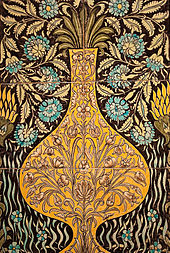William De Morgan

William Frend De Morgan (16 November 1839 – 15 January 1917) was an English potter, tile designer and novelist.[1] A lifelong friend of William Morris, he designed tiles, stained glass and furniture for Morris & Co. from 1863 to 1872. His tiles often recall medieval or Islamic design patterns. He applied innovative glazes and firing techniques. Galleons and fish were common motifs, as were "fantastical" birds and animals. Many of De Morgan's tiles were designed to create intricate patterns when several were laid together.
Life and work

Born in Gower Street, London,
In 1872, De Morgan set up a pottery in
De Morgan's decoration of pottery included chargers, rice dishes and vases. Some of these were made in his works, but many were bought as biscuit ware from Wedgwood and others and decorated by De Morgan's workers. Some were signed by his decorators including Charles Passenger, Fred Passenger, Joe Juster and Miss Babb.[5]


De Morgan was particularly drawn to Eastern tiles. Around 1873–1874, he made a striking breakthrough by rediscovering the technique of

The pottery works was beset by financial problems, despite repeated cash injections from his wife, the pre-Raphaelite painter Evelyn De Morgan (née Pickering), and a partnership with the architect Halsey Ricardo. This partnership was associated with a move for the factory from Merton Abbey to Fulham in 1888. During the Fulham period De Morgan mastered many of the technical aspects of his work that had previously been elusive, including complex lustres and deep, intense underglaze painting that did not run during firing. However, this did not guarantee financial success, and in 1907 De Morgan left the pottery, which continued under the Passenger brothers, the leading painters at the works. "All my life I have been trying to make beautiful things", he said at the time, "and now that I can make them nobody wants them."[citation needed]
De Morgan turned his hand to writing novels, and became better known than he ever had been for his pottery. His first novel, Joseph Vance, was published in 1906,[6] and was an instant sensation in the United States as well as the United Kingdom.[7] This was followed by An Affair of Dishonour, Alice-for-Short, and the two-volume It Never Can Happen Again (1909).[8] The genre has been described as "Victorian and suburban".[who?]
De Morgan died of trench fever in London in 1917, and was buried in Brookwood Cemetery. Recollections praise him for his personal warmth and the indomitable energy with which he pursued his kaleidoscopic career as designer, potter, inventor and novelist.[citation needed]
Museums and collections

Collections of De Morgan's work exist in many museums, including the
A number of properties in the UK open to the public have tiles and pottery on display or incorporated in the building's decoration. They include
See also
References
- ^ Phelps, William Lyon (March 1917). "William De Morgan". North American Review: 440–446.
- Oxford Dictionary of National Biography, Oxford University Press [1], Retrieved 20 April 2008.
- ^ "Fitzroy Square Pages 52–63 Survey of London: Volume 21, the Parish of St Pancras Part 3: Tottenham Court Road and Neighbourhood. Originally published by London County Council, London, 1949". British History Online. Retrieved 4 August 2020.
- ^ "Settlement and building: Artists and Chelsea Pages 102–106 A History of the County of Middlesex: Volume 12, Chelsea". British History Online. Victoria County History, 2004. Retrieved 21 December 2022.
- ^ William Gaunt and M. D. E. Clayton-Stamm. 'William De Morgan', Studio Vista, London 1971, p. 168.
- ISBN 9780804718424.
- The World's Work: A History of Our Time. XVI: 10337–10342. Retrieved 10 July 2009.
- ^ XIX Century Fiction, Part I (Jarndyce, Bloomsbury, 2019).
- Hamilton, Mark (1997). Rare Spirit A Life of William De Morgan 1839–1917. London: Constable. p. 236. ISBN 0-09-474670-2.
Further reading
- Higgins, Rob; et al. (2010). William de Morgan: Arts and Crafts Potter. Shire Library. p. 64. ISBN 978-0-7478-0738-4.
- Stirling, A. M. W. (1922). William De Morgan and His Wife. New York: Henry Holt and Company. ISBN 1-112-26408-6.
- Greenwood, Martin (1989). The Designs of William De Morgan. Richard Dennis and William W. Wiltshire III. ISBN 0-903685-24-8.
External links
- About William De Morgan
- Article on the William Morris – William De Morgan Collaboration at William Morris Tile
- Beth Russell information
- "Archival material relating to William De Morgan". UK National Archives.
- Portraits of William De Morgan at the National Portrait Gallery, London
- Works by William De Morgan at Project Gutenberg
- Works by or about William De Morgan at Internet Archive
- Works by William De Morgan at LibriVox (public domain audiobooks)

- Papers of William De Morgan held at Senate House Library, University of London
- William De Morgan at the Internet Speculative Fiction Database
- William De Morgan at Library of Congress, with 16 library catalogue records
- William De Morgan Collection. General Collection, Beinecke Rare Book and Manuscript Library.
